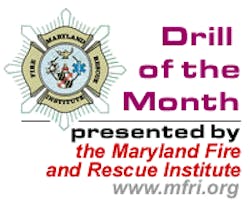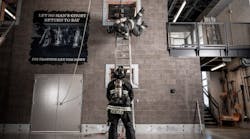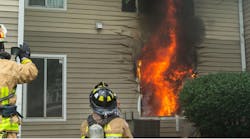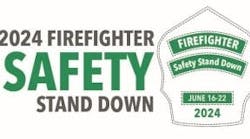Instructor Guide
Title: Personal Safety Awareness (Revised 6/2010)
Teaching and Learning Domain: Cognitive
Time Required: 2 Hours
Materials: Appropriate visuals and chalkboard or easel pad
References: IFSTA Essentials of Firefighting (5th ed.)
Motivation: The fire and rescue service has acquired an unfortunate reputation of accepting injury and death as part of the job. This is unacceptable and must be turned around. Every member of the fire and rescue has a personal responsibility to make the job and the environment safer.
Student Performance Objective (SPO): Given information from discussion, handouts, and reading materials, describe and recognize personal safety concerns related to emergency operations that may require corrective action.
Enabling Objectives (EO): EO 1-1-1 Identify certain practices that could be considered unsafe and result in injury or death.
Overview:
• Safety Awareness Checklist
- SAFETY AWARENESS CHECKLIST (EO 1-1-1)
This drill is intended to be conducted as an interactive discussion between the discussion leader (instructor) and the participants rather than a safety lecture. Everyone is expected to actively participate. This should be used a more of a brainstorming session with the possibility of getting new ideas to make the department safer. Care should be exercised to avoid criticizing any comments since this may inhibit participation.
The list is by no means all-inclusive and in only limited by the knowledge and expertise of the members.
- The outline is presented in the form of a personal safety checklist or a series of questions with no specific right or wrong answer. During the discussion, the reason for each item being considered unsafe should be explained along with some suggestions of actions that could be taken to make the action safer.
- Do you hydrate on a regular basis so that you are ready for the next alarm, work activity, or training session?
- Are you in good health and physical condition when you are on duty?
- Do you get sufficient rest so that you are ready to perform when the need arises?
- Are you careful about following instructions when taking medication, especially medication that may induce drowsiness or impair body or mental functions?
- Do you listen to the dispatch when receiving an alarm so that you will get all the information that is being transmitted?
- Are you complacent on certain types of alarms or alarm locations?
- Do you stay with your officer and crew when operating on the emergency scene?
- Do you operate within the departmentís accountability system so that someone will know where you are on the emergency scene at all times?
- Do you observe smoke conditions and smoke color as you approach the scene so that you have a better understanding of what might be taking place?
- Do you observe fire conditions and fire color as you approach the scene so that you have a better understanding of what might be taking place?
- Does your personal protective clothing fit properly?
- When donning your personal protective clothing, do you put it on completely and correctly and make sure that there is no exposed skin?
- Do you and your buddy check each otherís personal protective clothing to make sure it is donned correctly before entering the work area?
- Do you wear clothing under you personal protective clothing that will increase your protection level?
- Do you know how to tie basic knots that you may need to use on the emergency scene?
- Do you wear eye protection on the emergency scene whenever you are not wearing an SCBA facepiece?
- Do you wear hearing protection when working with any equipment generating noise such as a generator, power saw, or rescue tool power unit?
- Do you stand to the side when pressurizing a hand portable fire extinguisher?
- Do you have a secondary means of fire control and suppression in place in the event that the hand portable fire extinguisher is unable to extinguish the fire?
- Do you walk a hoseline to get any kinks out?
- Do you open and close nozzles and other water control appliances slowly?
- Do you open nozzles completely when attacking a fire?
- Do you use the proper fire attack technique to minimize upsetting the thermal balance?
- Do you make sure that all hose couplings are secure before charging lines?
- Do you make sure that the hoseline (preconnect) is completely out of the hosebed before it is charged?
- Do you make sure that all hoseline are connected before charging lines?
- Do you make sure that hose appliances are open completely when being used?
- Do you know where the water is going before you begin to discharge it?
- Do you ventilate to remove heat, smoke, and steam before you begin the fire attack?
- Do you know where all the other firefighters are before you begin a fire attack?
- Do you check the nozzle pattern before beginning your fire attack?
- Do you secure hose when it is being extended up a ladder?
- Do you have adequate staffing on nozzles and hoselines?
- Do you know the limitations of your SCBA?
- Do you know your own limitations when using SCBA?
- Do you understand the by-products of combustion, especially the toxic ones?
- Are you observant of obstacles and traps that can cause you to get harmed on an emergency scene?
- Do you know how to use hose couplings to find you way in or out of a building?
- Do you know what to do when lost or disoriented?
- Do you know how to activate your PASS device in an emergency?
- Do you know how to effect a self-rescue if you are trapped in a structure?
- Do you know how to properly lift a ground ladder?
- Do you know how to properly carry a ground ladder?
- Do you know how to properly raise a ground ladder?
- Do you know the proper hand and foot position when raising or lowering a ground ladder?
- Do you watch for overhead obstructions when raising a ground ladder?
- Are you careful with soft ground surfaces when raising a ground ladder?
- Do you raise the ladder to the proper length for a roof or window operation?
- Are you careful to avoid overloading a ground ladder?
- Do you maintain contact with the ground ladder with a least one hand when you are climbing?
- Do you secure yourself to the ground ladder when you are working off it?
- Do you know where the fire is at all times when you are working in a structure?
- Do you coordinate ventilation with fire attack?
- Do you know the appropriate type of ventilation (NPV/PPV) to use in a particular situation?
- Do you use knots that work for the particular application, e.g., hoisting tools?
- Do you check to make sure force is necessary before you make entry?
- Do you check to make sure what is on the other side before making entry?
- Do you carry tools properly?
- Do you maintain tools so that they will work properly when needed?
- Do you use tools safely?
- Do you observe the circle of safety when using tools, especially power tools?
- Do you provide lighting of the emergency scene and in the interior as needed?
- Do you clear openings after making forced entry?
- Do you start from a safe point when pulling a ceiling?
- Do you have a charged hoseline ready before making an opening in a wall, ceiling, or floor?
- Do you always work in pairs?
- Do you have credible information regarding a trapped victim before initiating a search for victims?
- Do you use tools and accessories to assist in conducting a search and rescue?
- Do you wear personal protective clothing and SCBA during overhaul?
- Do you control utilities before making openings in walls?
- Do you approach a vehicle fire from a safe direction?
- Do you wear full personal protective clothing and SCBA on vehicle fires?
- Do you have at least an 1-1/2-inch attack line when attacking a vehicle fire?
- Do you approach a dumpster fire from a safe direction?
- Do you wear full personal protective clothing and SCBA on dumpster fires?
- Do you have at least an 1-1/2-inch attack line when attacking a dumpster fire?
- Are you constantly aware of the weather conditions on a wildland fire?
- Do you know and follow the ten standard fire orders for wildland firefighting?
- Do you take any special precautions when operating on a wildland fire at night?
- Do you know what to do if lost or hurt while on a wildland fire?
- Are you seated and wearing a seatbelt whenever the apparatus is in motion?
- Do you wait for the apparatus to come to a full stop before entering or exiting?
- Do you put on your SCBA while responding to the emergency scene?
- Do you watch for traffic conditions as you respond to the scene?
- Do you watch for traffic as you exit or work around the apparatus at the emergency scene or backing into station?
- Do you watch for open compartment doors as you work around the apparatus?
- Do you look before you step on or off of apparatus?
- Do you watch when climbing on apparatus to reach tools or equipment that may be placed high?
- Do you put on your personal protective clothing before boarding the apparatus?
- Do you avoid running to board apparatus?
- Do you avoid running on the emergency scene?
- Do you stay on the apparatus until given an assignment either by the officer or as the result of your departmentís standard operating procedures?
- Do you watch out for other arriving apparatus when exiting apparatus or working on the emergency scene?
- Do you make sure that everyone is ready before charging a hoseline?
- The outline is presented in the form of a personal safety checklist or a series of questions with no specific right or wrong answer. During the discussion, the reason for each item being considered unsafe should be explained along with some suggestions of actions that could be taken to make the action safer.
REVIEW:
• Safety Awareness Checklist
REMOTIVATION:
Safety begins with each individual member of the fire and rescue service. The brothers and sisters of the fire and rescue service must watch out for each other to avoid causing injury to themselves or others. The bottom line is that everyone goes home from each incident or other activity safely and is able to go on the next incident. An injury or death statistic is one that each of us is better being let out of. Safety begins with you.






